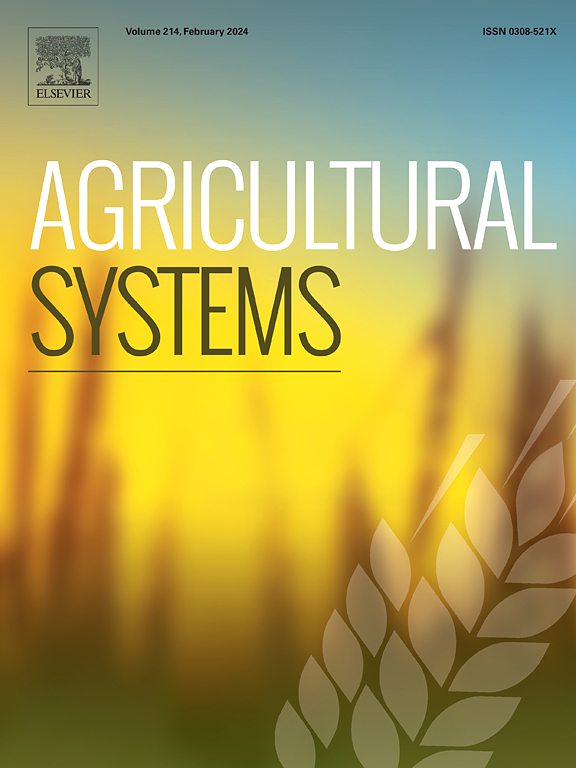Money doesn't grow on trees – Or does it? How agroforestry system design makes agroforestry more attractive to smallholders in Senegal
IF 6.1
1区 农林科学
Q1 AGRICULTURE, MULTIDISCIPLINARY
引用次数: 0
Abstract
CONTEXT
In the Sahel region, agroforestry, if upscaled, is a promising land restoration measure to combat the effects of climate change. Beyond its environmental benefits, agroforestry potentially increases crop yields or provides tree products. While the presence and quantity of trees ensures environmental outcomes to a certain degree, the potential economic benefits can only be realized from more sophisticated agroforestry system (AFS) designs. Yet smallholders' preferences for different AFS design concepts and related potential outcomes remain neglected in research focusing on smallholders' adoption behaviour.
OBJECTIVE
We want to understand smallholders' preferences for potential agroforestry benefits within their adoption intentions. We aim to compare established adoption determinants for smallholders' willingness to adopt, and willingness to pay (WTP) or willingness to accept compensation (WTA) for three individually suited AFSs design concepts targeting different benefits: environmental benefits; environmental benefits and increased crop yields; environmental benefits, increased crop yields and individually preferred tree products.
METHODS
We interviewed 606 smallholder farmers in the Senegalese Groundnut Basin. Employing an open-ended contingent valuation method, we elicited smallholders' WTP or WTA for the three AFSs. We then employed a Heckman regression for each AFS to analyse smallholders' willingness to adopt and their WTP or WTA for respective system.
RESULTS AND CONCLUSIONS
Several smallholders who initially are unwilling to adopt agroforestry, even for financial compensation, change their stance for an AFS that provides economic benefits. Others switch from an initial compensation demand to being willing to pay. Smallholders who remain reluctant to adopt, state reasons such as a lack of space. The baseline probability of smallholders to be willing to adopt changes from negative for the first AFS to statistically significant and large positive for the third AFS. This suggests, that an economic benefit provision might offset agroforestry adoption constraints detected in past adoption studies. Smallholders WTP increased and WTA decreases with each additional economic benefit of the AFS. Our results suggest a substitutive effect between alternative local income sources and agroforestry adoption. Further smallholders generally perceive agroforestry as a means to mitigate and adapt to climate change effects.
SIGNIFICANCE
Ongoing initiatives should reconsider their policies to design AFSs that align with smallholders' preferences for economic benefits. Agroforestry policies in the Sahel should be designed to aim for increased suitability and profitability of AFSs for smallholders. Further, Non-Governmental Organizations that specialize in agroforestry extension should target the communication of agroforestry as not only environmentally beneficial, but also economically beneficial.

求助全文
约1分钟内获得全文
求助全文
来源期刊

Agricultural Systems
农林科学-农业综合
CiteScore
13.30
自引率
7.60%
发文量
174
审稿时长
30 days
期刊介绍:
Agricultural Systems is an international journal that deals with interactions - among the components of agricultural systems, among hierarchical levels of agricultural systems, between agricultural and other land use systems, and between agricultural systems and their natural, social and economic environments.
The scope includes the development and application of systems analysis methodologies in the following areas:
Systems approaches in the sustainable intensification of agriculture; pathways for sustainable intensification; crop-livestock integration; farm-level resource allocation; quantification of benefits and trade-offs at farm to landscape levels; integrative, participatory and dynamic modelling approaches for qualitative and quantitative assessments of agricultural systems and decision making;
The interactions between agricultural and non-agricultural landscapes; the multiple services of agricultural systems; food security and the environment;
Global change and adaptation science; transformational adaptations as driven by changes in climate, policy, values and attitudes influencing the design of farming systems;
Development and application of farming systems design tools and methods for impact, scenario and case study analysis; managing the complexities of dynamic agricultural systems; innovation systems and multi stakeholder arrangements that support or promote change and (or) inform policy decisions.
 求助内容:
求助内容: 应助结果提醒方式:
应助结果提醒方式:


